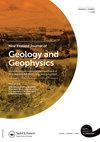Tsunami or storm deposit? A late Holocene sedimentary record from Swamp Bay, Rangitoto ki te Tonga/D’Urville Island, Aotearoa – New Zealand
IF 1.9
4区 地球科学
Q1 GEOLOGY
New Zealand Journal of Geology and Geophysics
Pub Date : 2022-06-22
DOI:10.1080/00288306.2022.2087692
引用次数: 0
Abstract
ABSTRACT Informed by Māori oral histories that refer to past catastrophic marine inundations, multi-proxy analysis of stratigraphic records from Swamp Bay, Rangitoto ki te Tonga (D’Urville Island) shows evidence of an anomalous deposit extending some 160 m inland. The deposit includes two distinct lithofacies. The lower sand unit is inferred to have been transported from the marine environment, with corresponding increases in the percentages of benthic marine and brackish–marine diatoms, and geochemical properties indicative of sudden changes in environmental conditions. Radiocarbon dating indicates the deposit formation is less than 402 yrs BP, and pollen indicates it is unlikely to be younger than 1870 CE. Core stratigraphy age models and co-seismic chronologies point to the marine unit most likely being emplaced by tsunami transport associated with rupture of the Wairarapa Fault in 1855 CE. The overlying unit of gravel and silt is inferred to be fluvial deposit and slope-wash from the surrounding hills, loosened by ground-shaking following the earthquake. These findings indicate the 1855 CE earthquake may have been more complex than previously thought and, or, available tsunami modelling does not fully capture the local complexities in bathymetry and topography that can cause hazardous and localized tsunami amplification in embayments like Swamp Bay.海啸还是风暴沉积?新西兰奥特亚汤加兰吉托岛沼泽湾/D’Urville岛的全新世晚期沉积记录
本文章由计算机程序翻译,如有差异,请以英文原文为准。
求助全文
约1分钟内获得全文
求助全文
来源期刊
CiteScore
5.10
自引率
27.30%
发文量
34
审稿时长
>12 weeks
期刊介绍:
Aims: New Zealand is well respected for its growing research activity in the geosciences, particularly in circum-Pacific earth science. The New Zealand Journal of Geology and Geophysics plays an important role in disseminating field-based, experimental, and theoretical research to geoscientists with interests both within and beyond the circum-Pacific. Scope of submissions: The New Zealand Journal of Geology and Geophysics publishes original research papers, review papers, short communications and letters. We welcome submissions on all aspects of the earth sciences relevant to New Zealand, the Pacific Rim, and Antarctica. The subject matter includes geology, geophysics, physical geography and pedology.

 求助内容:
求助内容: 应助结果提醒方式:
应助结果提醒方式:


